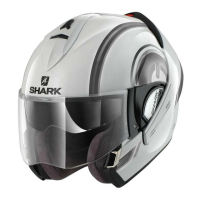4948
A
B
C
-
-
-
-
-
SYSTEM OF AERATION
Upper ventilation:
The upper air intake (Fig. A) allows air to enter
onto the upper part of the head and thus re-
new the air in the head section. The channels
incorporated in the internal shock absorbers
facilitate the circulation of air over the surface
of the head.
The quality and design of the textile comfort
parts contribute to the proper distribution of
air. The position of the upper ventilation sys-
tem is designed to optimise the effectiveness
of its intake of air. Depending on the type of
your motorbike, the fairing may reduce the
effectiveness of this ventilation.
The ventilation is in the open position when
the tongue is pushed backwards and closed
when the tongue is pushed forwards (Fig. B).
Lower ventilation (chin section):
The principal function of this air intake is to di-
rect a flow of fresh air over the interior surface
of the visor in order to limit the risk of misting.
The fresh air diffused cuts off contact with the
hot air emitted by breathing or even by the head
inside the helmet.
The presence of fairing may also reduce the
effectiveness of this ventilation. In extreme
weather conditions (for example, under heavy
rain or extreme cold, etc.) the risk of misting is
greater and we advise you, under these condi-
tions, to use the visor slightly open. Ventilation
is open when the tongue is pushed downward
and closed when it is upward (Fig. C ).
-
-
-
-
-
-
-
-
-
SISTEMA D’AERAZIONE
Ventilazione superiore:
La presa d’aria superiore (Fig. A) consente un
ingresso dell’aria sulla parte superiore della
testa, nonché il rinnovo dell’aria della cuffia. I
canali integrati agli elementi smorzatori interni
semplificano la circolazione dell’aria sulla su-
perficie della testa.
La qualità e la concezione dei tessuti di com-
fort aiutano a garantire una corretta diffusione
-
-

